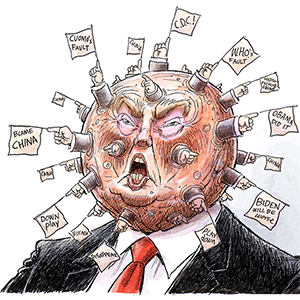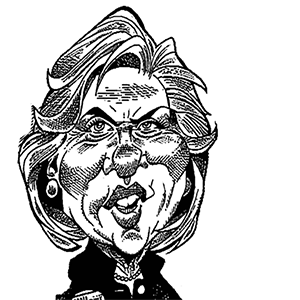Commentary: Political centrism has been getting a second look. Why?
Published in Op Eds
Political centrism has a bad name.
In fact, it has a lot of bad names. Centrists have been denigrated as squishy, weak in the knees, guilty of being sellouts — and worse, unpatriotic.
However, the idea of centrism has been getting a second look recently. Americans are feeling like they are imprisoned for life in the politics of extremism and rage, and they’ve become more desperate to break out. Voters are just exhausted, according to many surveys.
Americans have tried Democratic control of the government. They’ve tried Republican control. They’ve also tried divided government. Very soon, they will toy with either “democratic socialism” under Kamala Harris or anarchical libertarianism and untethered randomness under Donald Trump.
Especially in the final days of this tumultuous 2024 campaign season, centrism doesn’t look so squishy after all, does it? Politically, it has gone from being considered a sedative to a stimulant.
Centrist themes are popping up in conversation; institutional organizations are adopting it as a cause. Political leaders are holding seminars and conferences on the subject. Commentators and pundits are giving it ink and airtime.
Cases in point: A recent article in The Atlantic by Yuval Levin, “What’s Wrong with Congress (And How to Fix It),” advocates for “cross-partisan coalition building,” among other centrist-leaning congressional reforms.
South Dakota Rep. Dusty Johnson wrote recently, “We need thoughtful discourse among engaged citizens, not emotional attacks from enraged partisans,” in introducing his “six paths to civility.” Current and former senators and members of Congress have created the movement Our Republican Legacy to restore the party to its founding principles, which were more traditionally conservative and centrist in their direction.
But what is centrism? Is it an ideology, a composite of ideas and beliefs that comprise a political philosophy? Or is it a methodology, simply a form of decision-making in a polarized environment?
Centrism gets its energy and appeal from civil discourse, a knowledgeable citizenry and a distinct set of political values. It is also a pattern of decision-making that puts greater emphasis on pragmatism, bipartisanship, incrementalism, reason and tolerance for divergent beliefs.
It is a lot more than splitting the difference between two contrasting pieces of legislation. Centrism is often an entirely fresh approach to a problem.
It is founded on reasoned judgment rather than emotional belligerence. It is an antidote for extremism and a path toward making politics and government work again. It is not a third party, but it could provide the framework for one. You don’t have to sacrifice your principles to engage in centrist governance.
All of that doesn’t mean centrism is a panacea. Far from it. In politics as in much of life, panaceas don’t exist. There are no cure-alls in an imperfect system created and run by imperfect human beings. But centrism may be a way out of the political and social mess we’ve gotten ourselves into.
Consider illegal immigration. The issue was, due to neglect, a problem that turned into a partisan, political, humanitarian, economic, constitutional and international crisis. There was no need for that. Now it has become a catastrophe to resolve. Workable solutions have been on the table over the decades, but because of polarized politics, only a rare few have been enacted.
There are dozens of other issues that suffer the same fate as immigration, among them Social Security and Medicare, the need to upgrade the energy grid and the rising tide of public debt. They, too, have become so complex that no resolution seems possible.
Those at the extremes have argued that a centrist approach is just settling for half a loaf, but in the 1980s, President Ronald Reagan and House Leader Bob Michel, for whom I served as chief of staff, were fond of reminding us that the alternative was no loaf at all, which is what we are left with more often today. They and other reasoned and reasonable leaders, most notably one-time Senate Majority Leader Howard Baker Jr., understood the machinations of a divided Congress and engaged in the kind of coalition building that gave America a working government.
It seems House Speaker Mike Johnson and Democratic House Leader Hakeem Jeffries have shopped at the same bakery. On several occasions, they have been able to create an atmosphere in which bipartisan cooperation, pragmatic negotiations and sensible solutions are possible. So have others at the committee and subcommittee levels.
Good leaders know that serving the public interest first also means recognizing that the fears, anxieties and the sense of abandonment that have exhausted millions of Americans are legitimate sensibilities that need assuaging. They just want the work of government to get done and their lives made better, which is the focus of “Fixing Congress: Restoring Power to the People,” a book I co-authored with Jerome F. Climer.
Centrism is a solution. An ample number of current and future political leaders could assume the mantle of centrist leadership. It is up to Americans, the media and political institutions to draw them out, encourage that concept and give them platforms for advancing a new way to conduct the nation’s business.
And when? Hopefully, within my lifetime. I and so many others are getting too old for this.
____
Michael S. Johnson spent 47 years serving in the White House, Congress, private sector media relations and advocacy, as well as a number of nonprofit organizations dedicated to improving the work of the legislative and executive branches.
_____
©2024 Chicago Tribune. Visit at chicagotribune.com. Distributed by Tribune Content Agency, LLC.




























































Comments